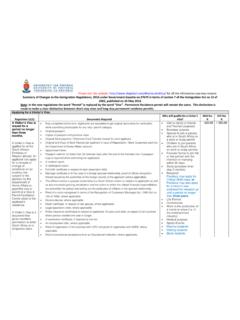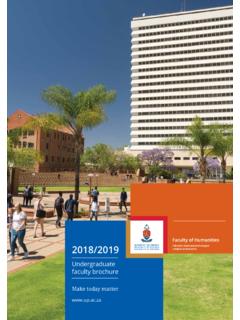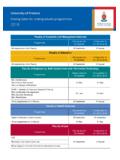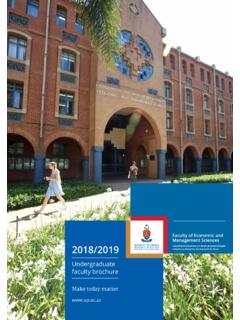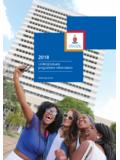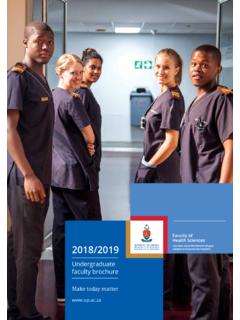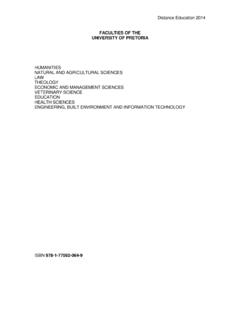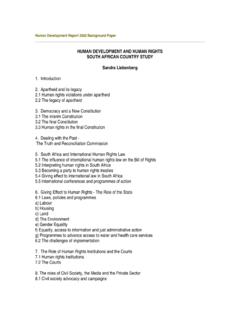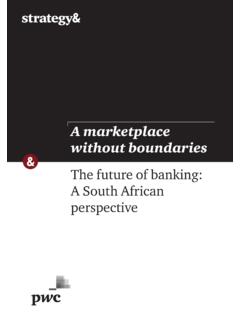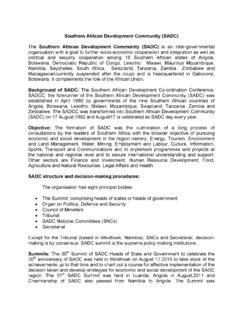Transcription of THE SIMILARITIES AND DIFFERENCES BETWEEN SOUTH …
1 THE SIMILARITIES AND DIFFERENCES BETWEEN SOUTH african AND CHINESE DEFINITIONS AND DESCRIPTIONS OF LEADERSHIP STYLE: A MINING JOINT VENTURE CASE STUDY Ms Rayne C. Handley Department of Management Rhodes University PO Box 94, Rhodes University Grahamstown 6140 SOUTH Africa Tel: (+27) 74 454 7404 E-mail: Mr Mattheus J. Louw Department of Management Rhodes UniversityPO Box 94, Rhodes University Grahamstown 6140 SOUTH Africa E-mail: ABSTRACT The purpose of this paper is to explore the SIMILARITIES and DIFFERENCES BETWEEN SOUTH african and Chinese definitions and descriptions of leadership style through a case study of a Chinese- SOUTH african joint venture (hereafter referred to as ABC). The purposive sample included management and supervisory level employees from the head office and mining operation of ABC who were willing to participate in the study. In-depth semi-structured interviews were used to collect data which was analysed using content analysis.
2 The study found SIMILARITIES and DIFFERENCES BETWEEN SOUTH african and Chinese leadership definitions and dominant leadership styles as described by Chinese and SOUTH african participants. Overall, the study recommends that transformational leadership is more effective than transactional and laissez-faire leadership. Idealised influence and contingent reward are strongly exhibited by both SOUTH african and Chinese participants. Finally, Chinese participants in this study note that they do not exhibit individualised consideration leader behaviour as strongly as SOUTH Africans do. INTRODUCTION Increasing globalisation has created a growing presence of multinational organisations and trade (Dodds, 2014). The resulting cross-cultural and intercultural organisational context needs to be researched in order to create a non-pejorative, empirically researched and well established body of knowledge to reduce cultural conflicts and enhance cohesiveness (Bird and Fang, 2009; Br utigam, 2009; Brewster, Carey, Grobler, Holland and W rnich, 2008).
3 Intercultural research relates to interactions BETWEEN cultures, seeking to understand how different cultures function together (Samovar, Porter, McDaniel and Roy, 2014: 5-6) while cross-cultural research pertains to the analysing of different cultures and comparative research across cultures (Johnson, Lenartowicz and Apud, 2006). China is SOUTH Africa s largest trading partner, and the 2015 signing of new agreements BETWEEN China and Africa following the 2015 FOCAC summit speaks to increasing China-Africa engagement (BBC News, 2015). With the rapidly changing world and global business environment, Proceedings of the 28th Annual Conference of the Southern african Institute of Management Scientists ISBN: 978-0-620-71797-7 Page 138workforce expectations are changing and competition is becoming increasingly difficult to manage. As such, effective international leadership is imperative for organisational success, if not survival (Weinberger, 2009).
4 Wang, Freeman and Zhu (2013) highlight the fact that Chinese firms have experienced several challenges in global expansion and that there are insufficient effective cross-cultural leaders to ensure organisational success. Effective leadership within an intercultural workplace is complicated given that perceptions of effective leadership behaviour vary across countries and cultures (Brewster et al., 2008: 281). Nevertheless, certain universally endorsed leadership practices such as transformational leadership have been identified (Walumbwa, Orwa, Wang and Lawler, 2005: 249). RESEARCH PURPOSE AND OBJECTIVES There is a need to understand the dynamics of Chinese- african intercultural engagement, particularly at the organisational level, so as to enhance synergies (Park and Alden, 2013; Jackson, Louw and Zhao, 2013). The studies purpose is to understand what DIFFERENCES and SIMILARITIES exist BETWEEN Chinese and SOUTH african descriptions of leadership style.
5 Given the lack of indigenous leadership definitions, the study will initially seek to define leadership indigenously. To meet the primary research purpose above, the following research objectives have been set: To identify the key SIMILARITIES and DIFFERENCES BETWEEN Chinese and SOUTH african definitions of leadership. To explore the SIMILARITIES and DIFFERENCES BETWEEN Chinese and SOUTH african dominant leadership styles and leadership dimensions within the intercultural context. To make recommendations on how to effectively lead in a similar intercultural context. LITERATURE REVIEW Definition and nature of leadership style From a Western orientation, leadership is typically described as being a process (Bass, 2007: 11), an interaction BETWEEN leaders and followers (Bass, 2007: 11; Yukl, 2006) or a personality or behaviour (Amos, Ristow, Ristow and Pearse, 2008: 197; Bass, 2007: 11; Yukl, 2006) which results in leaders influencing followers (Bass, 2007: 11) so as to attain organisational goals (Amos et al.)
6 , 2008: 197; Bass, 2007: 11; Yukl, 2006). Leadership is distinguishable from management in that leadership speaks to a form of engagement as opposed to a hierarchical distinction which is generally indicative of management (Amos, 2012: 373). african and Chinese leadership definitions are notably excluded from the current related literature and as such western parameters exist in the search for what can be considered effective leadership (Nkomo, 2011; Javidan, Dorfman, Sully de Luque and House, 2006). Descriptions of african leadership generally centre on social influence, voluntary participation, and on serving and stewardship which engender commitment rather than on egocentric behaviour that can at best offer compliance (Large, 2008: 59). Successful african leadership is thus not about holding a position of power in the organisational hierarchy, but concerns personal power that enables individuals to create their own future and quality of life.
7 Looking at a Chinese perspective, Tsai, Tsai and Wang (2011: 5321) define leadership as the general characterization of a leader s thinking, behaviour and organisational environment. It can be viewed as a series of managerial attitudes, behaviours, characteristics and skills based on individual and organizational values, leadership interests and reliability of employees in different situations . Effective leadership qualities include discipline, authority, benevolence and moral integrity (Wu and Wang, 2014). This paper asserts that both universally endorsed and culturally distinct leadership styles and characteristics exist (Browaeys and Price, 2011; Van Zyl, 2009). Moreover, universally endorsed Proceedings of the 28th Annual Conference of the Southern african Institute of Management Scientists ISBN: 978-0-620-71797-7 Page 139leadership styles, for example charismatic or value-based, humane-orientated, and self-protective leadership, are likely to manifest differently across cultures.
8 Consequently it is important to develop culturally aware leaders (Selvarajah and Meyer, 2007; Pittinsky and Zhu, 2005). Cultural relativity of leadership There are few available empirical studies that look at leadership behaviour and perceptions of leadership within Asia and Africa. Most studies have a Western orientation or are dismissive of culture (Selvarajah and Meyer, 2007; Pittinsky and Zhu, 2005). Despite the enduring presence of non-Western leadership, the prevailing body of knowledge is dominated by a Western perspective (Br utigam, 2009; Hofstede, 1993). National culture scales are often reductive in nature and do not accurately describe the nuances and specific cultural values of a country, serving more as a comparative tool than seeking to describe cultural values (Jackson, 2012). Understanding how culture affects intercultural work environments is important given distinct DIFFERENCES BETWEEN Western and indigenous organisational practices, notwithstanding leadership (Jackson, 2011; Thomas and Bendixen, 2000: 509).
9 China and SOUTH Africa can both be described as highly diverse nations; however, China is seen to possess a stronger common cultural value system than SOUTH Africa does (Hafsi and Yan, 2007). Great variation in cultural values and consequent behaviour is seen across the ethnic groups of SOUTH Africa, rendering the analysis of a national culture relatively less beneficial (Blunt and Jones, 1997). An in-depth examination of culture is beyond the scope and length of the current study. However, a brief interrogation of cultural SIMILARITIES and DIFFERENCES expected to affect leadership behaviour will be presented. The importance of positive interpersonal relationships and collectivistic values which lead to social harmony are indicative of both Chinese and SOUTH african culture (Zhou and Martocchio, 2001; Blunt and Jones, 1997). Without being reductive, familial collectivism can be argued to manifest in contemporary Chinese and SOUTH african business practices (Jackson, 2012: 195; Hafsi and Yan, 2007).
10 Chinese and SOUTH african cultures are also often described as paternalistic (Zhu, Zhang and Shen, 2012: 3967). Paternalism affects leadership, given a disposition towards control and hierarchy, which result in an exchange of benevolence for loyalty and respect (Fang, 2006; Zhou and Martocchio, 2001: 117). A notable difference however BETWEEN Chinese and SOUTH african leaders is the Chinese predilection to equity versus the SOUTH african tendency to promote equality (Horwitz, Kamoche and Chew, 2002: 1030). Jackson (2012: 195) argues that Chinese values of benevolence, moral righteousness and a respect for etiquette and norms may enable cohesion and satisfactory outcomes. The Chinese leaders of organisations operating in Africa can thus create power structures, relationships, decision making and management processes that engender these values, resulting in fair wages and safe working environments, fair-dealing with customers, providing benefits to the community, being a good corporate citizen, promoting social good generally and protecting the environment (Jackson, 2012: 195).
